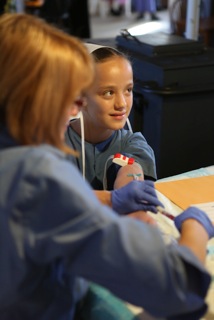-
Allergy Answers in Amish Country
 The Amish kind of sneak up on you. We came in from the west, from South Bend, Indiana, heading towards Middlebury along Highway 20. At first, farms had tractors, houses had cars. Then, at the back of one house, a buggy was parked. Then a ways down we saw a horse and buggy on the road. Then, in Middlebury, we noticed a whole row of horses and buggies parked in front of a big box store. A few miles later, in the farm country east of Middlebury, the farms were all clapboard white and you couldn’t see a car or truck parked at any of them.
The Amish kind of sneak up on you. We came in from the west, from South Bend, Indiana, heading towards Middlebury along Highway 20. At first, farms had tractors, houses had cars. Then, at the back of one house, a buggy was parked. Then a ways down we saw a horse and buggy on the road. Then, in Middlebury, we noticed a whole row of horses and buggies parked in front of a big box store. A few miles later, in the farm country east of Middlebury, the farms were all clapboard white and you couldn’t see a car or truck parked at any of them.This is Amish country, one of a number of communities scattered mostly in Ohio, Pennsylvania and Indiana. We came here because the University of Chicago was running a blood clinic in the basement of Ervin and Ruby Mast’s farmhouse. The Amish would prefer not to be photographed. Being photographed suggests a lack of humility. But Ervin said he would allow us to film his family, as long as they didn’t have to look at the camera or speak to it. This was a rare opportunity for us to film an Amish family, a whole community, at work and play, and in the service of science.
The Amish dairy farmers in America live a lifestyle similar to the dairy farmers of southern Germany, a cohort studied by Munich immunologist Erika Von Mutius because they seem to be relatively free of allergies. Surprisingly, Indiana allergist Mark Holbreich found that the rate of allergies in the Indiana Amish is even lower than in the German farmers. What is it about the way they live that protects them from allergies and asthma? The blood clinic allows the scientists to look for genetic markers that would help explain the protection.
Upwards of 24 families were involved. They began arriving around 10 am in small buggies, big buggies, horseback and bicycle. The strict Amish communities have frozen their culture in roughly the year 1840. Modern inventions are shunned. They won’t use cars, airplanes, telephones, televisions, radios or, of course, computers. There are a few exceptions. They use a stainless steel vat to store their milk, otherwise they couldn’t sell it. And the Masts have a small tractor – a Bobcat – to help with work. Illumination is courtesy of propane. And the young men get jobs with the town’s Recreational Vehicle manufacturer (they’re good carpenters and specialize in cabinet-making.)
The Amish children were the subject of the blood-testing. Three nurses gently extracted about a half-pint of blood from each of them. They were from eight to sixteen years old, and not once did any of us hear a word of complaint, a cry, a whimper; they were absolutely stoic. If these were children from my local school there’d be a lot more noise.
I asked the geneticist, Carole Ober, why she thought that was. (She’d noted it too.) She said she thought maybe it was because their lives were uncluttered, and so their minds were uncluttered too. They didn’t have irrational fears; they trusted their elders. They weren’t bombarded and confused by a world of TV shows, movies, stars and starlets, websites and virtual worlds, smart phones and pop music. There was no competition because they all had the same, they all dressed the same, they all lived the same. They continued to exist in a state of calm.
After the blood clinic, we visited the barn for the afternoon milking. In walked two little angels, Maria, 4 and Amanda, 2, Erwin and Ruby’s grandchildren. They wore the traditional Amish bonnets and billowing dresses, and they had a pet kitten and dog with them. They then proceeded, unknowingly, to illustrate the hygiene hypothesis, or, more specifically, the farming effect – the possible explanation for why these farm kids don’t get allergies. They walked through fresh cow paddies, they were barely missed by streams of cow piss, they were slapped in the face with cow’s tails, and they picked up and fondled their pets, which had also been roaming free through the milking barn’s Boschian environment.
What Mark Holbreich wants to know is what exactly, in this miasma of bacteria, viruses, and other microbes that make up a dairy farm, is supplying the protection against allergies?
Or is it the unpasteurized milk they drink? The research continues.
We were all – the researchers, the camera crew, the extended Mast family – invited to dinner. We were asked by an elder to tell the gathering where we were born, where we lived and maybe a bit about our families. While we and the researchers could tell stories of world travel and a huge variety of experiences, the Amish each related more or less the same story: they were born in this very building, or nearby. They’d lived nearby all their lives. The men farmed, the women cooked and quilted. And so it will be (they hoped?) for all time. If we all took up their lifestyle, the environmentalist in me thought, we could probably save the planet.
Before we left, we visited a ploughing demonstration, as two of Erwin’s grown-up children considered the latest ploughing rigs. Pulled by work horses, the ploughs dug deep and even. The work was almost noiseless. The men would stop the drivers sometimes and talk about this or that in Dutch-German. And then the ploughing would continue, with potential buyers in straw hats, suspenders, white shirts and beards without moustaches, following behind, talking and laughing.
Back in South Bend the next day, my cameraman shopped for a Notre Dame hat and we learned the famous college team was having a winning season, something the nearby Amish didn’t know about or care about. – Bruce Mohun, director, THE ALLERGY FIX
- Welcome
- Our Films
- Cracking Cancer
- The Antibiotic Hunters
- Weather Gone Wild: Surviving a World of Superstorms
- Generation Jobless
- The Allergy Fix
- To the Rescue
- Where Am I?
- The Boomer Revolution
- Programmed to be Fat?
- Generation Boomerang
- Thoroughly Modern Marriage
- X-Cars
- Hyper Parents & Coddled Kids
- The Downside of High
- Peace Warrior
- Desperately Seeking Doctors
- Depression: Fighting the Dragon
- Embracing Bob’s Killer
- Coming Soon
- Store
- Blog
- About Us









